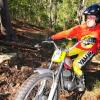| |
-
The rubber dampers inside do develop play after a while. The rubbers can be replaced.
I made new rubbers and rivets about 35 years ago for one of my TY175s, thinking that the play there might be affecting on-off-on throttle work, but I could not feel any difference in the behaviour of the bike between before and after, so I have never bothered doing it on any other TY175s.
The subject comes up on these forums every few years.
-
I confess not reading the instructions with the damper rods and set mine to 125mm dip with Dexron ATF, rode a trial, then set them to 125mm dip with 5WT fork oil
-
It's a Victorian bike and Jared rode it at a Denman Club (Hunter Valley, NSW) event a few years ago ( a long way from home for both Jared and I).
Are you going to make a standard shape header?
That's a comfortable-looking seat. Did you make it?
I bought a set of the Majesty brand damper rods too and am impressed with the damping action
-
Here is another TY250 (not mine) with a DT250 head showing the other side. It has the cut-away cylinder fins of the A or B model cylinder
-
Maybe there is also a thermal benefit with the DT250 head which could be important up here
-
What I think I can see apart from what you have already mentioned are:
DT250 cylinder head.
The exposed section of the fork tubes below the bottom clamp looks a bit longer than standard.
Handlebar clamps are a bit further forward than standard.
-
Lifting the rear is a normal thing in trials riding. Some people call it unweighting the rear
-
Yes I bent mine to get the tip the right height after replacing the fixed footpegs with folding footpegs. I see the arm that the rod connects to on mine is at a completely different angle too
-
12 52 is good for trials competition use with a standard motor. 428 chain is good.
-
maybe crankcase contains a lot of petrol
-
I've ridden an EM 5.7 and found it did have flywheel effect.
On any bike the smooth application of power has a lot to do with the mind-body connection of the rider. I have found that any bike (including the EM 5.7) feels right and works well once I have tuned myself to the way it responds.
-
I bought one like that from Keith Lynas
-
I'm wondering why you are limiting so much your choice of what bike to ride
-
Try Jared Bates at Southwest Montesa in USA
-
I'm using an OKO carby which gives a bit of clearance there
-
WES two box or good custom exhaust, ignition with a decent advance curve, free flowing airbox, lighten flywheel, non-offset carby-to-reed cage adaptor, light seat, light tank. Standard size carby is fine for 175cc
-
I've got a 348 (which is pretty much the same in that area). I usually fit the airbox last.
Fit cylinder connector to cylinder, fit carby to cylinder connector, fit airbox connector to airbox, fit airbox
-
That was great to see. Thanks Dave
-
Here is I photo I have already showing the brake pedal. The bike in the photo is a very early M49 which shares many components with the M27, including the brake pedal.
I will take more photos to show the pedal and mount better, maybe taking the footrest off
I don't have any way to show the stand mount because I removed what was left of the broken-off mounting.
-
Q1 sounds like a restricted pilot jet or low speed circuit
Q2 sounds like the fan motor bearings need some lube
Q3 Yes make sure there is not too much transmission oil, then if it still does it, the gearbox may be getting pressurised
-
I can do close-up photos and take measurements if you want to make a replica
-
Have you tried using the bearing dimensions to find the bearing ID for the second bearing, using the same pattern as the other bearing. It is likely to be another Koyo bearing.
The first bearing number 20NQ3212 comes from:
20mm ID, NQ = type of bearing, 32mm OD, 12mm wide
-
I remember someone posting their local rules up years ago and there was a rule that really got my imagination working:
"The rear wheel exits the section before the front wheel" (scores a 5)
-
The in-line axle 35mm Pursang forks I inspected today have taper-top fork tubes which means they are from a Pursang that was made before they went to a clamp-type top triple clamp design which happened around 1972 from memory. The Pursang sliders are the same internally as leading-axle Alpina/Sherpa T/Matador fork sliders of the same era.
-
Sounds like something is wrong. I've fitted lots of tapered steer bearings to TYs and the nut has always screwed down to the same position on the stem as it did with the original bearings. A photo would be good
|
|


